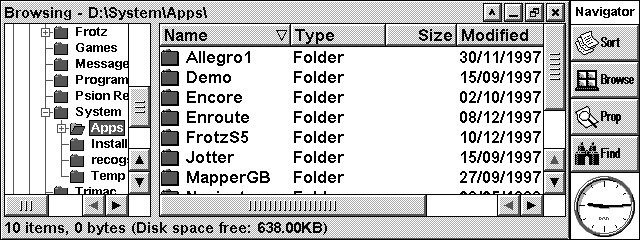
CE CF
A couple of months ago (in PC Pro issue 42, April 1998), I covered the use of PC Card memory with most PDAs. Since then it seems that more and more PDAs come with a CompactFlash (CF) slot either with, or instead of, a PC Card slot. A quick survey on my desk turns up a Psion Series 5, HP620LX, LG Phenom, and Everex Freestyle, all with CF slots, and of course an adaptor card that lets a CF card fit into a PC Card slot. The only devices I can see that have PC Card but no CF slots are all Newtons (and an eMate), plus an old Casio Cassiopeia A-11. CF cards are readily available in up to 32 Mb sizes, which a careful shopper can buy for under £200. Not only that, but CF cards for networking, modems and other specialised uses are all being shown, and should be available during the course of this year.
Using a CF card with the Psion Series 5 is simple and a pleasure. The only likely difficulty is that it is possible for a ham fisted user to force in the card upside down in the slot. For the record, the raised lip at the end of the card away from the socket should be facing away from the body of the Psion. The System screen or Navigator can browse the contents of the card, and applications correctly installed will appear in the Extras menu. There are no restrictions on saving documents anywhere in the file system, either in main memory, or on the CD card. This is a good implementation.
Browsing a CF card with a Series 5

Inserting a CF card into an HP620LX was a problem that beat even my thirteen year old gadget expert, the one that I use to program VCRs and set clocks on microwave ovens. The card has to be inserted onto a carrier frame that ensure that the card is the right way up before reinserting the carrier into the slot. It isn't immediately obvious, but the card should be placed in the carrier with the raised lip facing down.
With Windows CE, life is more complicated. If you insert a CF card, it appears in Explorer as Storage Card, and you can save files to it in the normal way. Used purely as a storage facility for extra documents, it works perfectly acceptably. However, unlike with the Psion Series 5, the databases used by the main applications (Calendar, Contacts, Tasks and Inbox) cannot be stored on a CF card. Apparently this restriction will be lifted with Windows CE 2.1, which will ship later this year, after the first crop of palm-sized PC devices. Installing applications is positively baroque. If the application has a PC based installer, it will give the option of installing to any directory, including the Storage Card. But taking a CF card out of one Windows CE machine and inserting it into another doesn't carry across most of the work of the installer program.
To install an application, you could just place it in any directory, then launch it from Explorer. That works, and has the considerable virtue of simplicity. To insert the application into the Start menu, the operation is very similar to that on Windows 95: create a shortcut from the installed location of the application to /Windows/Programs. So far so good. However, many applications require Registry entries to be set before they will work. Often just setting values in /HKEY_LOCAL_MACHINE/Software/Apps for the application name, like the InstDir value, is sufficient. This is fine using an installer application. But if you want to share applications between machines, you will need a way of setting values. If you have the SDK for Windows CE, this includes a remote registry editor so that value can be manually set from an NT machine, but this isn't satisfactory if you want to exchange applications on CF cards.
The best hack to bypass this problem is to install a Registry editor on your HPC. I use RegEdit (Registry Editor for Windows CE), by Felipe Jordao (tilde over the a), although there are several others that work equally well.
But even this solution won't work if you want to install to a palm-sized PC, as they don't have an Explorer application in order to launch RegEdit in the first place. The most likely use of a CF card with a palm-sized PC is as extended document storage only.
Words and design by:
Paul Lynch
Last updated: June 8, 1998